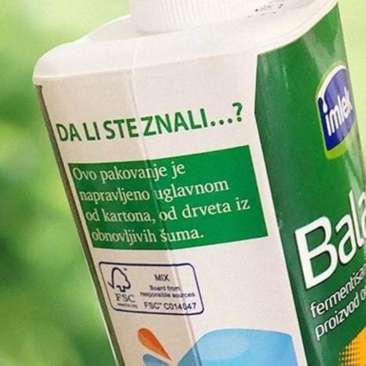
Introduction
Packaging in the food industry plays a very important role when it comes to product selection, and it is often made from the forest-based materials. Promoting the ecological type of packaging and ecological labelling are certainly useful forms of advertising and ways to attract as many consumers/buyers as possible. This is especially true if we consider milk. The milk market is flooded with numerous products that are of similar quality, therefore a product design or packaging colour can play a decisive role in the selection and purchase of this product.
The annual milk production in Serbia amounts to about 1,7 billion litres, and with a population over 6 million people, ecological packaging of this everyday product can make a significant difference when talking about responsible materials use and waste management. A recently published study by Šabac Academy aimed to determine what is the current situation in Serbia when it comes to ecological milk packaging and eco-labelling. Read the results below.
Research questions
-
What is the most common material used for milk packaging in Serbia?
When it comes to milk, there are generally four types of packaging:
- Tetra Pak,
- plastic bottles,
- plastic bags, and
- glass bottles.
In the one year period from July 2020 to June 2021, milk in Tetra Pak packaging had the largest share of sales.

The dominant packaging for milk in Serbia in the observed period was Tetra Pak packaging, which is multi-layered cardboard packaging for beverages consisting of 75% cardboard, 20% plastic and 5% aluminium foils.
There are six layers of Tetra Pak packaging and all of them are fully recyclable. Main material is the paper that gives stability and strength to the packaging. On the printed side of the paper, i.e. on the decor, a layer of polyethylene is applied to side, which serves as protection against external moisture. As protection against impact oxygen and light, aluminium foil is used, which is covered with a layer of polyethylene laminates on the inner - non-printed side of the paper. And finally, to ensure the protection of the final products (milk, juice) from contact with aluminium and to enable later formation packaging, two layers of polyethylene are applied, one that will protect the contents from contact with the other layers and one that serves to bond that layer of polyethylene to aluminium.
-
Which eco-labels are commonly used on milk packaging in Serbia?
Eco-labels are instruments whose goal is communication between producers and potential customers, by engaging producers to present their product as sustainable and environmentally friendly. Internationally recognised labels are used on the milk packaging, which indicate the characteristics of the packaging, as well as responsible consumer behaviour towards nature. Depending on whether the item can be recycled, how it is to be disposed of and whether it is made of recycled material, the labels can vary.
For the sake of this research question, 13 most present milk producers in Serbia were considered, and their 93 products were analysed for the presence of eco-labels. It was observed that the majority of manufacturer apply "The Green Dot", "Don't pollute the environment, let's protect nature" and the FSC label. Purpose of use of these labels is to show the social responsibility of the producer towards environmental protection and sustainable development, as well as to attract ecologically oriented customers.
Conclusion
According to the findings of this study, it may be said that the majority of milk lovers from Serbia consume their favourite white liquid from an ecologically friendly and FSC labelled packaging - ensuring that the forests are managed responsibly and are well preserved for the future generations.
Credits
This online article presents a published scientific study:
"Eco-design and usage of eco-labels on packaging for different types of milk", authored by Suzana Knežević, Milena Milojević, Biljana Delić Vujanović and Goran Stanišić, and published in June 2022.
This study was not financed by FSC. To access the full study, please use the link below.

